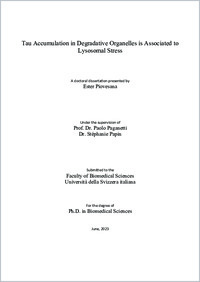Tau accumulation in degradative organelles is associated to lysosomal stress
- Piovesana, Ester
- Paganetti, Paolo (Degree supervisor)
- Papin, Stéphanie (Degree supervisor)
- 2023
PhD: Università della Svizzera italiana
Neurodegeneration
Alzheimer disease
Extracellular vesicles
Autophagy lysosomal pathway
Degradative organelles
Lysosomes
Glucosylceramidase
Gaucher disease
Tau
English
Neurodegenerative diseases, characterized by brain deposition of insoluble amyloidogenic proteins such as -synuclein and tau, constitute a major health risk for the aging population. The autophagy lysosomal pathway (ALP) involved in the degradation of intracellular macromolecules and protein aggregates is often impaired during neurodegeneration. Misfolded proteins involved in neurodegenerative diseases spread from one original site to defined brain regions through transcellular prion-like mechanisms and one possible route of transport relies on extracellular vesicles (EVs). We first established an in vitro model using murine neuronal progenitor C17.2 cells to investigate EVs-contained protein delivery. EVs carrying a pro-aggregating tau domain were isolated from donor cells and incubated with recipient cells. EVs were mainly internalized by endocytosis and EVs content was released in defined subcellular localizations termed degradative organelles (DOs). Importantly, in recipient cells endogenous tau was targeted through autophagic stimulation in DOs encountering there the exogenous fibrillogenic tau. This encounter led to subsequent cellular consequences such as tau accumulation and pathological tau conversion, two typical early hallmarks of tauopathies. We highlighted a new role of DOs being not simple degradative organelles but structures involved in more complex cellular functions. To better elucidate DOs functions in neurodegeneration we used a more relevant cellular system relying on human primary fibroblasts expressing fluorescent forms of tau in an inducible manner. When primary fibroblasts were incubated with pathological tau seeds extracted from Alzheimer’s disease brain tissue, we observed tau accumulation in DOs and lysosomal stress. Reciprocally, tau accumulation is observed when lysosomal dysfunction is induced in presence of an inhibitor of GCase, a lysosomal enzyme implicated in the lysosomal storage disorder Gaucher’s disease. Mutations in GCase encoding gene are the most frequent genetic risk in Parkinson’s disease. Our study supports a tight crosstalk between GCase activity, lysosomal dysfunction, and adverse tau accumulation, offering new clues for better understanding the pathogenesis of tauopathies such as Alzheimer’s and Parkinson’s disease.
- Collections
- Language
-
- English
- Classification
- Medicine
- License
-
License undefined
- Open access status
- green
- Identifiers
-
- NDP-USI 2023BIOMED003
- URN urn:nbn:ch:rero-006-121308
- ARK ark:/12658/srd1326073
- Persistent URL
- https://n2t.net/ark:/12658/srd1326073
Statistics
Document views: 189
File downloads:
- 2023BIOMED003: 417
